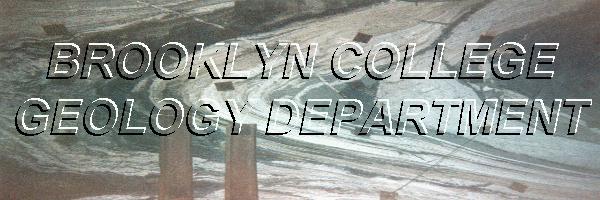 |
 |
| Prof. Nehru's Tunnel Field Trip |
 |
| Brooklyn College Geology "crew" and Prof. Nehru |
| CLICK HERE FOR MORE PICTURES OF THE TUNNEL FIELD TRIP |
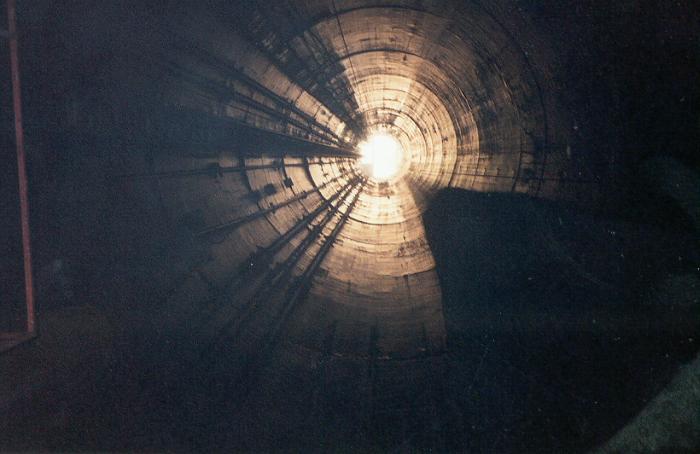 |
| 700 feet under |
The Geology Exposed by New York City Tunnel #3, Stage 2
Scott Chesman
Geologist
 |
 |
| Scott Chesman explaining the geology of the tunnel | Scott Chesman explaining the relationship between engineering and geology |
New York City’s Dept. of Environmental Protection
City Tunnel #3, Stage 2 is currently being excavated beneath Brooklyn and Queens at an average depth 0f 650 feet. The tunnel has an average rock cover of 450 feet with an additional 200 feet of overburden. The overburden consists of glacial outwash moraine and marine clay deposits of Pleistocene age as well as Cretaceous clays and sands. The bedrock consists of allochthonous units of the Hartland Formation (predominatly meta-igneous Proterozoic rocks).
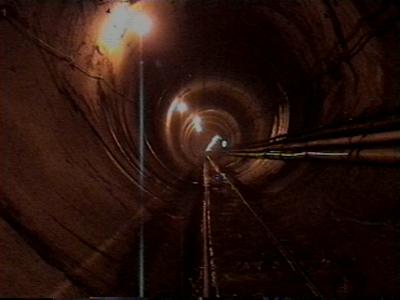 |
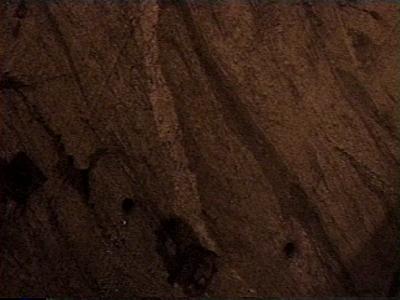 |
| View of tunnel | View of tunnel wall |
The predominate rock types are tonalite-trondhjemite-granodiorite (TTG) gneisses intermixed with more mafic sections composed of hornblende gabbros and diorites. Preliminary rare earth elements (REE) and trace element analysis indicate a lower to middle crustal origin for these rocks. Hornblende geothermometry as well as garnet microprobe studies undertaken by The City College of New York indicates upper amphibolite to granulite grade metamorphism. Migmatitic zones are prevalent throughout the section. Meta-sedimentary units as well as a possible dismembered ophiolite have been exposed. Metamorphosed mafic intrusives, tectonically sutured ultramafics and several granitic intrusive events all of uncertain ages are quite numerous.
Ductile deformations associated with several orogenic events have produced a widespread mylonitic fabric on the rock. The effects of the deformation (polygonization, subgrains, serrated grain boundaries and kink bands) are noticeable in thin section. Foliation strikes on average N40E, 50SE however these readings can vary due to the localized effects of faulting. Reactivated low angle thrust faults associated with the Taconic orogeny have conveyed several large inflows of groundwater. Several NNW, 75NE faults have created blocky conditions while several vertically dipping N-S striking faults were easily crossed. Along the tunnel line, two of the major joint sets strike NW while the third occurs along foliation. Most of the joint surfaces are mineralized, contain slickensides and are continuous.
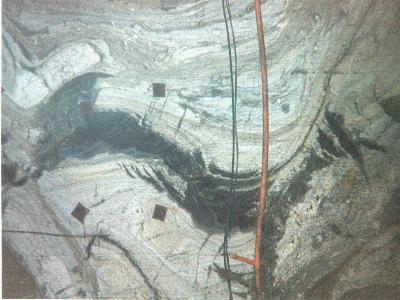 |
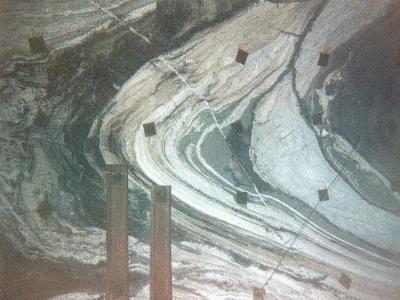 |
| View of a fault | View of a fold and a fault |
--------------------------------------------------------------------------------------------------------------------
The relationship between engineering and geology is perhaps no better emphasized than the excavation of a tunnel by a tunnel boring machine (TBM). In hard rock the TBM advances the face of the tunnel by propagating fractures in the rock between the TBM’s cutter disks (fig.1). The ability to fracture the rock depends on machine parameters such as the spacing of the disks as well as the thrust generated by the machine however, the overall design depends on what type of rock is expected to be encountered.
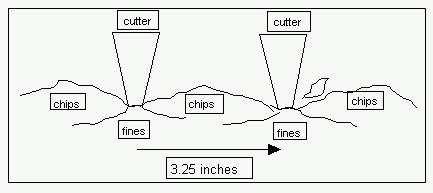
Various rock types have differing engineering properties quantified by its Young’s modulus and shear modulus values. These values are used to assist in predicting TBM performance. In a tunnel such as NYC’s the rock type varies between granodiorites and gabbros, which can relate to a 9 and 5 feet per hour penetration rate respectively. The percentage of each rock type predicted to be encountered could have a tremendous impact in estimating the time needed for excavation of a 29,000-foot long tunnel and thus the contracted bid price for mining.
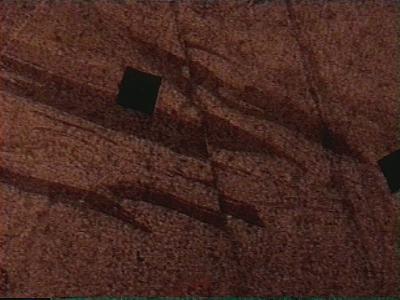 |
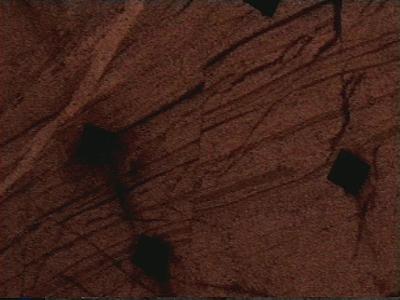 |
| View of a fault | View of a fault |
The abrasiveness of the rock is important for predicting cutter disk life. The more abrasive the rock the quicker the disks become dull and less efficient. Decreased cutter life equates to more down time spent changing the worn 350 pound disks (i.e. less time mining) plus the cost of the cutters. The abrasivity of the rock is in part determined by the percentage of 6-7 hardness minerals. Thus a quartzite can be more abrasive than a biotite schist. An increased presence of amphibole and garnet can greatly increase the abrasiveness of a rock therefore amphibolite to granulite grade metamorphic rocks may be expected to cause more difficulty.
Fractures created in the rock usually follow mineral grain boundaries. Quartz and potash feldspars usually have rounded grains while plagioclase grains can be angular. It is much easier to propagate a fracture along grain boundaries in a rock with granoblastic texture than a rock with isotropic sequential fabric. If the initiated fracture has to travel too far along or around angular grain boundaries it will have to cut across the mineral grains. This "short cut" can be especially difficult if the rock has been subjected to ductile deformation, which resulted in strain hardening of some of the minerals. For instance if a tonalitic gneiss (< 10% alkali feldspar) is viewed under thin section and the quartz has been deformed so that its grain boundaries have been sutured (angular and interlocking) and the quartz has underlatory extinction indicating crystal dislocations then one can assume that it will be a very tough rock to mine.
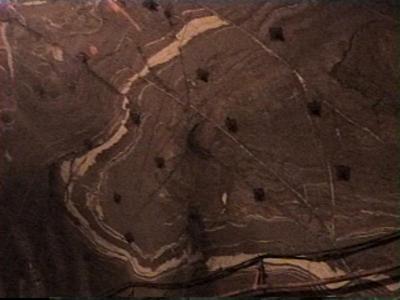 |
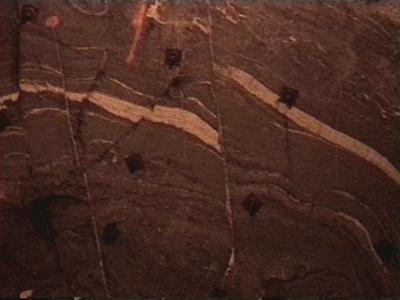 |
| View of an intrusion | Close up of an intrusion and a fault |
The deformational history of the area can be very important in predicting the engineering properties of the rock in certain sections of the tunnel. The Hartland formation as a whole is an allochthonous unit that was thrust perhaps 100 km against the Manhattan Prong group. Several faults associated with this tectonic event(s) are encountered in the tunnel and have produced a mylonitic fabric on the rock. In some sections the crystals have been annealed due to high temperatures resulting in a rock in which penetration rates could be considered reasonable. Others sections however, appear to have been deformed again during a later tectonic event but have not been annealed, resulting in lower than expected penetration rates. Brittle deformational events produce jointed to blocky rock conditions which, if not too shattered, enable higher penetration (>10 ft/hr) rates since the machine can take advantage of the preexisting fractures to remove the rock.
The orientation of the foliation as well as that of the main joint sets can also assist in mining if they are orientated favorably to the tunnel heading. The most favorable orientation of the discontinuities is that of ~ 60 degrees to the face. This allows the fractures created by the cutter discs to propagate outward intersecting the discontinuities and creating nice sized chips to be removed from the face. If the fractures are lined up perpendicular to the face most of the energy of the machine is robbed due to the tendency for the applied force to be concentrated at the tip of the discontinuity following Griffith’s modified theory of fracture propagation. If the discontinuities are parallel to the face no real advantage is obtained because the induced fractures will tend to have their energy redirected to the sides.
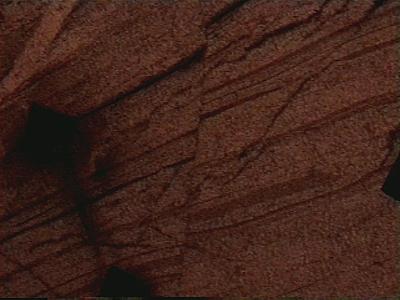 |
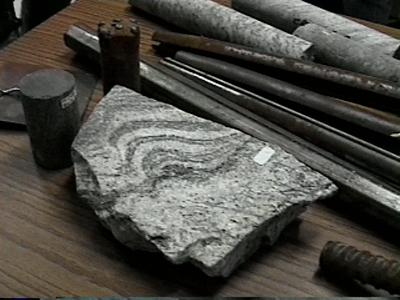 |
| View of a fault | Rock and core samples |
Residual stresses in the rock can create problems up to several months after excavation when large blocks of rock can loosen and fall with little warning. Many of the stressed areas have been noticed in the hinge areas of folds and along some of the more recent brittle faults. A set pattern of rock bolts has been installed along the entire length of the tunnel to reduce the risk of loosening blocks. A factor contributing to block instability is that most of the joints in the tunnel are mineralized, smooth and contain slickensides. Besides the low coefficient of friction associated with these features, swelling type clays (smectites) are found in the joints penetrating the more mafic sections of the tunnel. After exposure to the moist tunnel air the clays start to swell exerting pressure of the rock blocks.
Unexpected inflows of groundwater can create some of the most difficult conditions in tunneling even more difficult than blocky and/or unstable ground. Many of the faults in the region are low angle thrust faults from the Taconic, Acadian and possibly the Alleghanian orogenies that were reactivated during extensional tectonics. Due to the region’s least compressive force orientated in the vertical direction, as well as possible glacial unloading, these shallow dipping faults are open and can convey thousands of gallons a minute of groundwater into the tunnel. Extensive grouting operations have been required to stem the groundwater inflows along several of these low angle faults.
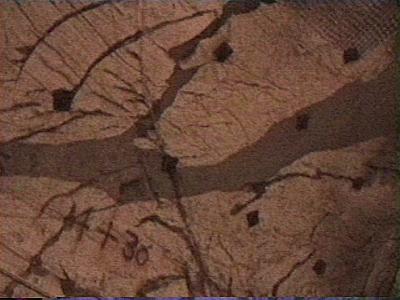 |
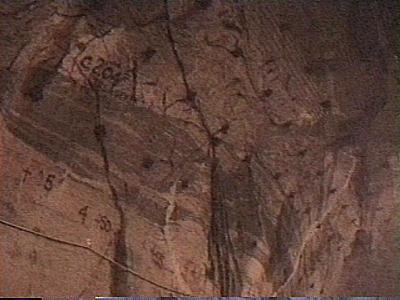 |
| View of successive intrusions | View of successive intrusions |
With the occasional presence of ultramafics it is possible to expose sections of serpentine. Monitoring of the tunnel air has been performed in these areas to ensure that fibrous amphiboles and chrysotile asbestos do not exceed OSHA limits. Levels of airborne silica dust are also monitored.
 |
| Updated and mantained by Guillermo Rocha |
